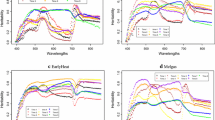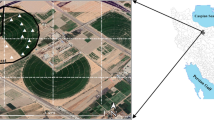Abstract
Increased availability of hyperspectral imagery necessitates the evaluation of its potential for precision agriculture applications. This study examined airborne hyperspectral imagery for mapping cotton (Gossypium hirsutum L.) yield variability as compared with yield monitor data. Hyperspectral images were acquired using an airborne imaging system from two cotton fields during the 2001 growing season, and yield data were collected from the fields using a cotton yield monitor. The raw hyperspectral images contained 128 bands between 457 and 922 nm. The raw images were geometrically corrected, georeferenced and resampled to 1 m resolution, and then converted to reflectance. Aggregation functions were then applied to each of the 128 bands to reduce the cell resolution to 4 m (close to the cotton picker's cutting width) and 8 m. The yield data were also aggregated to the two grids. Correlation analysis showed that cotton yield was significantly related to the image data for all the bands except for a few bands in the transitional range from the red to the near-infrared region. Stepwise regression performed on the yield and hyperspectral data identified significant bands and band combinations for estimating yield variability for the two fields. Narrow band normalized difference vegetation indices derived from the significant bands provided better yield estimation than most of the individual bands. The stepwise regression models based on the significant narrow bands explained 61% and 69% of the variability in yield for the two fields, respectively. To demonstrate if narrow bands may be better for yield estimation than broad bands, the hyperspectral bands were aggregated into Landsat-7 ETM+ sensor's bandwidths. The stepwise regression models based on the four broad bands explained only 42% and 58% of the yield variability for the two fields, respectively. These results indicate that hyperspectral imagery may be a useful data source for mapping crop yield variability.
Similar content being viewed by others
References
Anger, C. D. 1999. Airborne hyperspectral remote sensing in the future. In: Proceedings of the 4th International Airborne Remote Sensing Conference and Exhibition/21st Canadian Symposium on Remote Sensing, Vol. 1 (ERIM International Inc., Ann Arbor, Michigan, USA), pp. 1-5.
Bajwa, S. G., Tian, L., Bullock, D., Sudduth, K., Kitchen, N. and Palm, H. 2001. Soil characterization in agricultural fields using hyperspectral image data. ASAE Paper No. 011107, ASAE, St. Joseph, MI,USA.
Deguise, J. C., McGovern, M., McNairn, H. and Staenz, K. 1998. Spatial high resolution crop measurements with airborne hyperspectral remote sensing. In: Proceedings of the 4th International Conference on Precision Agriculture, edited by P. C. Roberts, R. H. Rust and W. E. Larson (ASA/CSSA/ SSSA, Madison, Wisconsin, USA), pp. 1603-1608.
ERDAS Inc. 1999. ERDAS IMAGINE tour guides. (ERDAS Inc., Atlanta, Georgia, USA).
Erickson, B. J., Johannsen, C. J. and Vorst, J. J. 2000. Using remote sensing to detect stand loss and defoliation in maize. In: Proceedings of the 5th International Conference on Precision Agriculture, edited by P. C. Roberts, R. H. Rust and W. E. Larson (CDROM, ASA/CSSA/SSSA, Madison, Wisconsin, USA).
ESRI Inc. 1999. Arc/Info user's guides. (Environmental Systems Research Institute Inc., Redlands, California,USA).
Mao, C. 1999. Hyperspectral imaging systems with digital CCD cameras for both airborne and laboratory application. In: Proceedings of the 17th Biennial Workshop on Videography and Color Photography in Resource Assessment, edited by P. T. Tueller (American Society for Photogrammetry and Remote Sensing, Bethesda, Maryland, USA), pp. 31-40.
Mao, C., Seal, M. and Heitschmidt, G. 1997. Airborne hyperspectral image acquisition with digital CCD video camera. In: Proceedings of the 16th Biennial Workshop on Videography and Color Photography in Resource Assessment, edited by P. T. Tueller (American Society for Photogrammetry and Remote Sensing, Bethesda, Maryland, USA), pp. 129-140.
Plant, R. E., Munk, D. S., Roberts, B. R., Vargas, R. L., Rains, D. W., Travis, R. L. and Hutmacher, R. B. 2000. Relationships between remotely sensed reflectance data and cotton growth and yield. Transactions of the ASAE 43(3), 535-546.
Roberts, D. A., Green, R. O. and Adams, J. B. 1997. Temporal and spatial patterns in vegetation and atmospheric properties from AVIRIS. Remote Sensing of Environment 62, 223-240.
SAS Institute Inc. 1988. SAS/STAT User's Guide (SAS Institute Inc., Cary, North Carolina, USA).
Shanahan, J. F., Schepers, J. S., Francis, D. D., Varvel, G. E., Wilhelm, W. W., Tringe, J. M., Schlemmer, M. R. and Major, D. J. 2001. Use of remote sensing imagery to estimate corn grain yield. Agronomy Journal 93, 583-589.
Shibayama and Akiyama. 1991. Estimating grain yield of maturing rice canopies using high spectral resolution reflectance measurements. Remote Sensing of Environment 36, 45-53.
Thenkabail, P. S., Smith, R. B. and De Pauw, E. 2000. Hyperspectral vegetation indices and their relationships with agricultural crop characteristics. Remote Sensing of Environment 71, 158-182.
Thenkabail, P. S., Ward, A. D. and Lyon, J. G. 1995. Landsat-5 thematic mapper models of soybean and corn crop characteristics. International Journal of Remote Sensing 15, 49-61.
Tucker, C. J., Holben, B. N. and Elgin, Jr. J. H. 1980. Relationship of spectral data to grain yield variation. Photogrammetric Engineering & Remote Sensing 46(5), 657-666.
Varner, B. L., Gress, T. A., Copenhaver, K., Wax, L. M., Sprague, C. L. and Tranel, P. J. 2000. Detection of cockleburs (Xanthium strumarium L.) in soybeans using hyperspectral imagery. In: Proceedings of the 5th International Conference on Precision Agriculture, edited by P. C. Roberts, R. H. Rust and W. E. Larson (CDROM, ASA/CSSA/SSSA, Madison, Wisconsin, USA).
Wiegand, C. L. and Richardson, A. J. 1984. Leaf area, light interception, and yield estimates from spectral components analysis. Agronomy Journal 76(4), 543-548.
Wiegand, C. L. and Richardson, A. J. 1990. Use of spectral vegetation indices to infer leaf area, evapotranspiration and yield: I. Rationale. Agronomy Journal 82(3), 623-629.
Willis, P. R., Carter, P. G. and Johansen, C. J. 1998. Assessing yield parameters by remote sensing techniques. In: Proceedings of the 4th International Conference on Precision Agriculture, edited by P. C. Roberts, R. H. Rust and W. E. Larson (ASA/CSSA/SSSA, Madison, Wisconsin, USA), pp. 1465-1473.
Yang, C. and Anderson, G. L. 1999. Airborne videography to identify spatial plant growth variability for grain sorghum. Precision Agriculture 1(1), 67-79.
Yang, C. and Everitt, J. H. 2002. Relationships between yield monitor data and airborne multidate multispectral digital imagery for grain sorghum. Precision Agriculture 3(4), 373-388.
Yang, C., Everitt, J. H., Bradford, J. M. and Escobar, D. E. 2000. Mapping grain sorghum growth andyield variations using airborne multispectral digital imagery. Transactions of the ASAE 43(6), 1927-1938.
Yang, C., Everitt, J. H., Davis, M. R. and Mao, C. 2003. A CCD camera-based hyperspectral imaging system for stationary and airborne applications. Geocarto International Journal 18(2), 71-80.
Author information
Authors and Affiliations
Rights and permissions
About this article
Cite this article
Yang, C., Everitt, J.H., Bradford, J.M. et al. Airborne Hyperspectral Imagery and Yield Monitor Data for Mapping Cotton Yield Variability. Precision Agriculture 5, 445–461 (2004). https://doi.org/10.1007/s11119-004-5319-8
Issue Date:
DOI: https://doi.org/10.1007/s11119-004-5319-8




